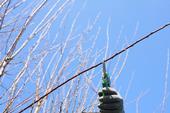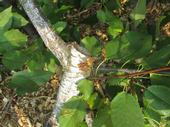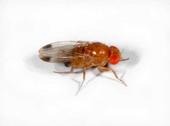
Winter is an ideal time to prune deciduous fruit and shade trees, since the trees are dormant and you can more easily see the tree canopy. In many cases, pruning can also help prevent or control certain insect and disease problems.
For help with pruning, visit the UC IPM web page called Pruning fruit and shade trees and shrubs.This page provides links to plant-specific pruning information for fruit trees, nut trees, landscape trees, and others. You can also find links to diseases and environmental disorders that commonly affect fruit and shade trees, as well as additional information on the topics of landscape management and videos on...
![Ripened cherry with sunken oviposition sites of spotted wing drosophila. [L. Strand]](https://ucanr.edu/blogs/UCIPMurbanpests/blogfiles/43803small.jpg)
As cherries begin to ripen on backyard fruit trees, you'll want to monitor the fruit for pests, especially an invasive species called the spotted wing drosophila (Drosophila suzukii).
The spotted wing drosophila (SWD) is a new pest to California (since 2008). It's a small fly that attacks ripening cherries, and may also attack ripening raspberry, blackberry, blueberry, and strawberry crops, especially in coastal areas. When conditions are right, the fly can also attack soft-fleshed fruit such as plums, plumcots, nectarines, and figs.
If your cherry tree has SWD, you might notice that fruit flesh has one or more small punctures or “stings” on the surface. These symptoms are evidence of the eggs laid...
![Cluster of ripe apricots [J.K.Clark]](https://ucanr.edu/blogs/UCIPMurbanpests/blogfiles/31578small.jpg)
Although most fruit trees are pruned during the dormant season, in areas with wet winters, apricots and cherries should be pruned in late summer to allow time for the pruning wounds to close. Pruning apricots and cherries during the rainy season could lead to detrimental canker diseases.
Cherries, apricots, and a few related species are particularly susceptible to fungal and bacterial canker diseases, including Eutypa dieback, Botryosphaeria canker, and bacterial canker. Pathogens can be spread by rain or tree wounds – such as pruning wounds – during wet weather; subsequent infections spread through the wood for several years and may eventually kill the tree.
Late summer is the best time to do final...
- Author: Chuck Ingels, UCCE Sacramento

Most people think about pruning fruit trees during the winter since the branch structure is most visible and winter is considered the traditional time to prune deciduous trees. Actually, pruning fruit trees mainly during the growing season is a good practice and with some species such as apricots and cherries, pruning between September and March in northern California could lead to detrimental canker diseases.
Cherries, apricots, and a few related species are particularly susceptible to fungal and bacterial canker diseases, including Eutypa dieback, Botryosphaeria canker, and bacterial canker. Pathogens can be spread by rain or tree wounds – such as pruning wounds – during wet weather; subsequent infections spread...
- Author: Mary Louise Flint

[From March 2013 issue of the Retail Nursery and Garden Center IPM News.]
Spotted winged drosophila (SWD), Drosophila suzukii, is a fruit fly that first arrived in California in the late 2000s and now is present throughout most of the state (Figure 1). It can attack various berry crops including strawberries, raspberries, blackberries, and blueberries; however, in backyards most complaints come from gardeners who grow cherries.
Unlike other fruit flies that attack fruit only after it has ripened and is starting to deteriorate, SWD attacks healthy fruit on the tree...


